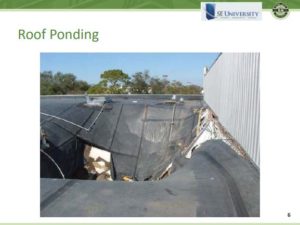 What is the best way to avoid a potentially catastrophic roof collapse due to ponding instability? Once you have determined that ponding could be an issue for your roof design, what is the most efficient way to improve the design to ensure adequate strength and stiffness to resist ponding?
What is the best way to avoid a potentially catastrophic roof collapse due to ponding instability? Once you have determined that ponding could be an issue for your roof design, what is the most efficient way to improve the design to ensure adequate strength and stiffness to resist ponding?
In the November 2020 SE University session, Mark Denavit, PhD, PE, from the University of Tennessee, Knoxville, presented New Methods for Ponding Analysis of Open Web Steel Joist Roofs. Mark’s session reviewed the main roof ponding requirements from design standards and described the limitations of the method of ponding analysis given in Appendix 2 of the AISC Specification. Mark demonstrated how to use the SJI Roof Bay Analysis Tool to determine the stability of a simple roof system and explained the main factors influencing the ponding stability of open web steel joist roofs.
When possible, Mark recommended to first avoid developing ponding loads on roofs by providing adequate slope to a free draining edge. This can be achieved by sloping roof members or using tapered insulation or sloping fill. Mark helpfully noted that parallel chord joists with end supports at different elevations are more economical than providing pitch into the joist top chords.
When ponding must be evaluated, the SJI’s Roof Bay Analysis Tool can be used to quickly and easily determine whether the roof framing is sufficient to resist ponding. If the tool shows that the roof is inadequate, aim to stiffen the roof members to reduce the additional load caused by ponding, or strengthen the roof members to resist the additional load. If possible, you may consider adjusting the shape of the roof to reduce the additional loads from ponding, or you may need to use a combination of these adjustments to reach a stable roof design.
